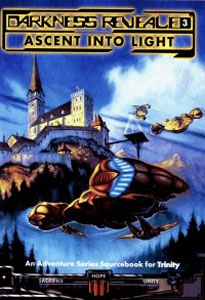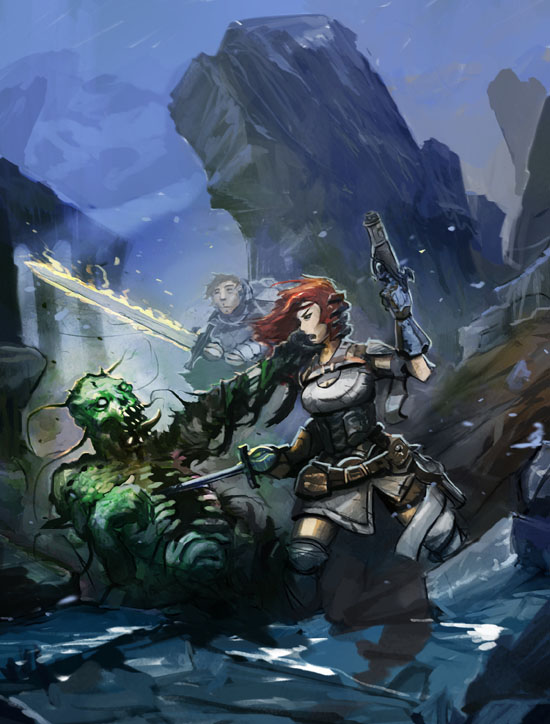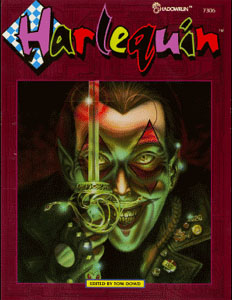Tagline: Learning from their previous mistakes, Bruce Baugh and Richard E. Dansky deliver one of the finest adventures ever as they bring the Darkness Revealed trilogy to a conclusion.
[ Ascent into Light is the third book in the Darkness Revealed adventure trilogy for Trinity. Plot points and spoilers are discussed. Do not read this review if you have any intention of playing in this adventure. I also encourage you to read my reviews for the first two books in the trilogy, as I will be including and concluding thoughts and arguments from those earlier reviews. ]
 This is how it is done.
This is how it is done.
With Ascent into Light the Darkness Revealed trilogy not only establishes itself as one of the finest adventures to ever be published for an RPG, it also becomes a textbook case of how designers who remain willing to learn from their previous mistakes are the best at what they do. It is also an excellent example of how to design and implement an adventure which gets the PCs involved in the highest echelons of a game world. Plus, Ascent into Light throws more shocking surprises into the Trinity universe than you typically expect from a year’s worth of White Wolf products.
High praise is deserved all around.
THE STORY
First, let’s recap the basic story as told in the first two volumes of Darkness Revealed: The PCs, working for Aeon Trinity, get assigned to investigate suspicious activity on Luna. They discover evidence of an illegal conspiracy within the Aesculapian psi order to conduct Aberrant-related experiments on human subjects – something called the Huang-Marr Project. They follow this trail to Mars and then back to Earth, where they uncover evidence that not only the Aesculapians, but also members of Orgotek are involved. The second volume, Passage Through Shadow, ends as they root out the last of Huang-Marr’s corrupting influences on an orbital station… but as they do so, the alien Chromatics appear in Earth orbit and assault the station! The PCs assist in the quick dispatch of these alien invaders.
Thus the stage is set for Ascent into Light: Humanity has learned the psions are not the pillars of virtue they have been portrayed as (raising old fears of “Aberrants among us”) and, as internal dissension begins to grow, we are suddenly threatened from the stars.
The first adventure in Ascent into Light, “Heaven Through Iron Gates”, starts just after the UN instigates a commission to investigate not only the implications of the Huang-Marr project, but also the possibility of more widespread corruption among the psi orders. Meanwhile, Aeon Trinity, in response to the Chromatic attack, dispatches the PCs with a strike force to Karroo (where humanity is in direct conflict with the Chromatics) in order to capture and interrogate Chromatics in an effort to find out where their homeworld is, how they found out where Earth was, and to figure out what they’re up to. (The hidden reason behind this is that Aeon Trinity wants the PCs, who are the key players in the revelation of Huang-Marr, out of the way until they can come up with a synchronized strategy for downplaying and spinning the anti-psion news.)
The PCs go to Karroo and succeed brilliantly in their mission, in the process making two startling revelations: First, that the Chromatics are preparing for a massive assault on Earth. Second, the true reasons behind the Upeo wa Macho’s disappearance (which ties into the Chromatic threat in a completely unexpected way – and, no, I’m not going to tell you; buy the book). Returning to Earth however, the PCs are told by their Aeon Trinity bosses that they shouldn’t warn the world of the Chromatics’ impending invasion – the Trinity wants time to prepare and take advantage of the situation.
“Heaven Through Iron Gates” ends as the PCs rebel against the Trinity and escape. Cliffhanger.
The second adventure, “Climbing to Tartarus”, picks up at the end of the cliffhanger. The PCs finally make their way to the UN headquarters on Luna, where they burst into the ongoing Huang-Marr inquiry and make their stunning announcements on interstellar holovid.
And that’s when the Chromatic invasion force shows up.
If the implications and pulse-pounding potential of this storyline doesn’t have you at, the very least, intrigued, then you might want to check your heart – it may have stopped pumping. And I’ve only covered the major, major stuff here; other major stuff (can you say “Doyen”?) I’ve left out entirely.
THE SETTING
A brief digression: In all my reviews of the Trinity product line I’ve never really mentioned how utterly stunning the setting is. By this I don’t mean just the detail and political intrigue (although they’re certainly there, and I’ve mentioned them before) – I mean that the imagination of Bates and his design team have cooked up some startling vistas which, when you capture them in the mind’s eye, take your breath away.
The Darkness Revealed trilogy has showcased some of the best – from orbital stations, to Luna bases, to the Summit Center which rotates around the top of Olympus Mons (until the PCs are involved in blowing it up), and much more.
One of the more startlingly original pieces is the mining colony Karroo – which, as mentioned above, appears in “Heaven Through Iron Gates”. Karroo is located in a “pocket” of the Crab Nebula. When the nebula, formed from the expanding remnants of a supernova, encountered a nearby planetary system the system broke apart into a massive asteroid field; but like a river hitting a rock, a “calm” was created behind the remnants of the system. This asteroid field is now known as “the Shield”, and Karroo is located in the (relatively) small, empty space on the far side of it. When you picture this small enclave of humanity, nestled among the “greatest aurora borealis in the galaxy”, it’s an awe-inspiring thing.
THE IMPLEMENTATION
Those of you who have read my previous reviews covering the first two volumes of the Darkness Revealed trilogy know that my estimation of the story underlying each of the products has always been high. On the other hand, you also remember that I felt each product was severely flawed in its implementation.
In particular I felt that Descent into Darkness was fatally flawed as an adventure – to take advantage of the outstanding story you would need to completely rework the adventures in order to make them playable. However, with Passage through Shadow I concluded that many of these problems had been fixed between one book and the next, leaving only two main concerns for me:
First, the color sections in the books (designed to be read by the players) actually succeeded at destroying the story (in one case by containing plenty of proof to arrest several of the characters the PCs were supposed to be investigating before the adventure had even begun; in another by giving the PCs information on a location they couldn’t possibly know they would be going to until midway through the adventure).
Second, that some of the transitions required specific conclusions to be made by the PCs – if those conclusions weren’t reached, you would be off course without a compass. (This was a fairly minor concern in Passage Through Shadow; noticeable only because the flaws in this area had been completely crippling in Descent into Darkness.)
Happily I can report that Ascent into Light solves both of these problems: The color sections not only have been stripped of their plot spoilers, but the second one actually serves as an intriguing plot point (as they are mysterious transmissions of information received from an unknown source throughout the adventure).
Besides the generalized excellence, there are a couple of features I want to point out in particular: First, the inclusion of insertion points; second, the in-built capability of alteration.
I have commented in my previous reviews on the great amount of effort put into making each and every adventure in the series accessible to any group of players – even if they haven’t played through the previous ones. These “insertion points” (as I call them) give the Storyteller multiple ways to bring his PCs into the story at any point during the Darkness Revealed trilogy. I was impressed by this before, I was flabbergasted when they managed to pull it off for Climbing to Tartarus.
If you noticed, above, Heaven Through Iron Gates ends as a cliffhanger, which Climbing to Tartarus picks up on. As I reached the end of Heaven I was convinced that the traditional insertion points would not be included for Climbing — this was not a bad thing: Climbing is the last adventure of a seven adventure series. Why would any Storyteller necessarily want to start there?
Unbelievably, however, an insertion point is introduced. And I’ll be damned if it doesn’t work just fine. Works incredibly well, actually. I can see exactly how Climbing could be played as a one-shot adventure.
I have also commented previously on how Baugh and Dansky have given extensive amounts of time to discussing how the basic structures of their adventures can be modified in various ways. Definite thumbs up on that. Once again, however, Climbing to Tartarus takes this to a new height – as the presented story is made accessible not only if the PCs betray Aeon Trinity at the end of Heaven Through Iron Gates, but also if the PCs decide to stay loyal to the Trinity.
Simply amazing. Based on a rock solid story, these adventures are flexible, dynamic, and enjoyable.
THE VERDICT
Ascent into Light, as the concluding volume of the Darkness Revealed trilogy, is one of the finest adventures you can buy for any roleplaying game. It possesses no weaknesses, only strengths. It only costs $15.95.
There’s absolutely no reason for you not to buy this book.
Style: 5
Substance: 5
Author: Bruce Baugh and Richard E. Dansky
Company/Publisher: White Wolf
Cost: $15.95
Page count: 120
ISBN: 1-56504-751-6
Originally Posted: 1999/08/06
For an explanation of where these reviews came from and why you can no longer find them at RPGNet, click here.
















